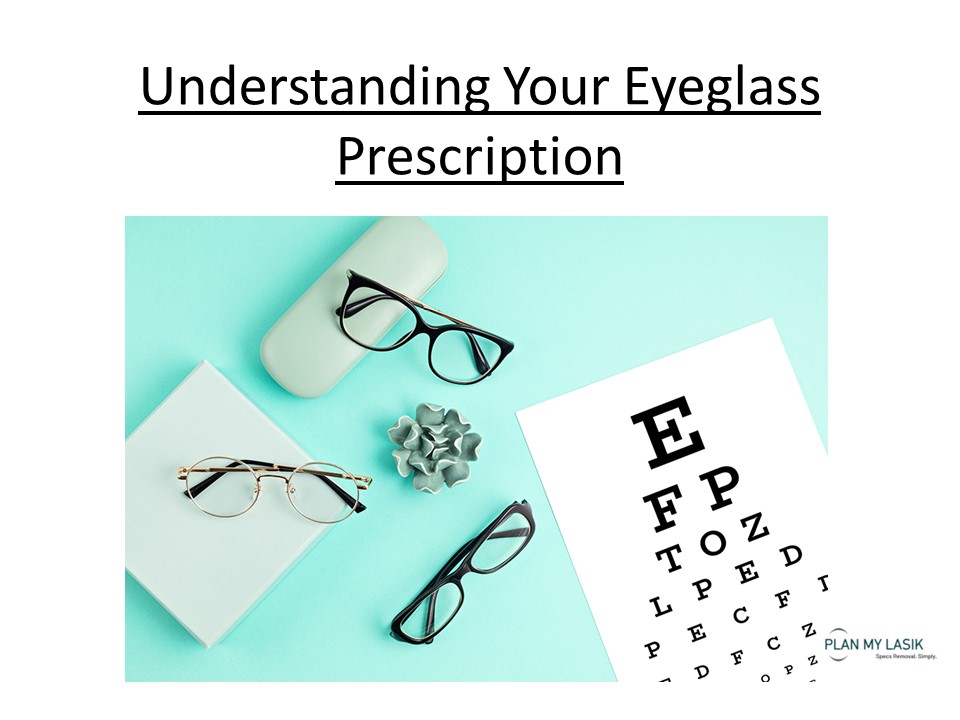How to Read your Eyeglass Prescription? - PowerPoint PPT Presentation
Title:
How to Read your Eyeglass Prescription?
Description:
It is tough to understand eye prescriptions written by ophthalmologists. They are generally a blend of letters and numbers. You may be in a state of confusion when you are not aware of its meaning. Let us understand how to read eyeglass prescription. – PowerPoint PPT presentation
Number of Views:4
Title: How to Read your Eyeglass Prescription?
1
Understanding Your Eyeglass Prescription
2
Introduction
Do you want to maintain good eyesight? In that
case, you have to go for eye exams at regular
intervals. This vital step will keep your eyes
healthy and retain the sharpness of your vision.
During an eye exam, an optometrist or
ophthalmologist will closely look for any early
signs of eye disease. It is tough to understand
eye prescriptions. They are generally a blending
of letters and numbers. You may be in a state of
confusion when you are not aware of its meaning.
Let us understand how to read eyeglass
prescription.
3
What the Numbers Represent?
You glance at your prescription for glasses, you
will encounter a couple of numbers, such as OS
and OD. OS stands for oculus sinister that is
left eye. OD stands for oculus dextrus, which is
the right eye. On certain occasions, you will get
to see OU, which is a situation involving
both eyes.
4
Unit Measurement
If your eyesight needs correction, you will get a
prescription for glasses or lenses. The
prescriptions will differ from individual to
individual when issues vary. These numbers refer
to dioptres. This is the unit of measurement of
lens power. In short form, the diopter is
referred to as "D."
5
How to Read Eyeglass Prescription?
Generally speaking, the more the deviation of the
number on the prescription, the worse is
your eyesight condition. A plus () notation
symbol in front of the number indicates you
are farsighted. A minus (-) notation symbol
means you are nearsighted. For instance, -1.00
on your prescription means you have one diopter
of near-sightedness. This is on the mild side. On
the other hand, -4.25 on your prescription mean 4
and 0.25 diopters of near-sightedness. Compared
to the first case in the second one, you will
require more powerful lenses. On the same lines
of thought, 1.00 indicates a small amount
of farsightedness, when compared to 5.
6
Reading the Prescription of Astigmatism
Some people have a cornea condition called
astigmatism. This is a condition that refers to
imperfections in eye curvature. In such
circumstances, an individual will have blurry
vision at all times. People suffering from this
condition will have three numbers on the
prescription. They are written in S x C x Axis
format. The cornea is in the shape of a football
instead of a basketball.
7
The S is a reference to the "spherical" portion.
It indicates the magnitude of near-sightedness or
farsightedness, as discussed in the above
paragraphs. The C is a reference to the
"cylinder" and can be either a negative or a
positive number. It indicates the extent
of astigmatism that you are suffering from, and
the unit of measurement is diopters. The bigger
this number, the higher astigmatism has impacted
you. The Axis shows the astigmatism
orientation. The number may be between 0 to 180
degrees. Stating the extent of astigmatism you
are suffering from is not adequate. It is also
helpful to gather information about the point
where curvature difference happens.
8
Two instances of the way prescriptions with
astigmatism would appear -3.00 2.50 x 90 2.50
1.00 x 135 The first prescription indicates that
the individual has 3 diopters of near-sightedness
with 2.5 diopters of astigmatism and an axis of
90 degrees. The second prescription refers that
the individual having 2.5 diopters of
farsightedness, 1 diopters of astigmatism, and an
axis of 135 degrees.
9
Conclusion
Your prescription may have notes from your Lasik
surgery specialists. The lenses may be
anti-reflective, progressive, or photochromic.
Some of them may have a coating on them that
makes them scratch-resistant. If the Latin
abbreviations and mathematical numbers bother
you, talk to your healthcare provider to clarify
issues. A wise approach is to have your eyes
examined at least once a year. This step is
crucial if you want to maintain your eye health.































